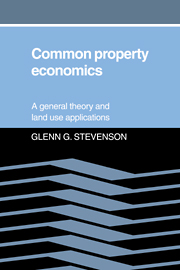Book contents
- Frontmatter
- Contents
- List of Tables and Figures
- Preface
- 1 What Is Common Property?
- 2 Open Access Theory
- 3 Common Property
- 4 The Swiss Grazing Commons
- 5 Comparisons with the English Open Field System
- 6 An Econometric Comparison of Commons and Private Grazing
- 7 The Structure and Performance of Common Property: Conclusions
- References
- Index
6 - An Econometric Comparison of Commons and Private Grazing
Published online by Cambridge University Press: 16 September 2009
- Frontmatter
- Contents
- List of Tables and Figures
- Preface
- 1 What Is Common Property?
- 2 Open Access Theory
- 3 Common Property
- 4 The Swiss Grazing Commons
- 5 Comparisons with the English Open Field System
- 6 An Econometric Comparison of Commons and Private Grazing
- 7 The Structure and Performance of Common Property: Conclusions
- References
- Index
Summary
Chapter 2 showed that a resource is not exploited optimally under open access, and Chapter 3 laid out the differences between open access and common property. This discussion has presented the possibility that common property, contrary to the faults attributed to it when it is thought of as open access, may allocate resources as well as private property. Unraveling the theoretical puzzle, however, does not answer the empirical question: Can common property perform as well as private property in the real world? Because it is a group solution, some of the incentives inherent in group use that one observes under open access will remain under common property. Once access has been limited to a certain number of users, one might well ask whether common property controls on individuals—such as stinting and regulations requiring contributions to joint welfare—can overcome the incentives to cheat on the group solution. This chapter explores the question empirically, comparing common property with private property in Swiss alpine grazing. I use private property as a benchmark in the empirical comparison because economists generally agree that private property leads to good resource allocation. If we are to know whether common property provides adequate resource management on more than just theoretical grounds, an empirical comparison with private property is a good place to start.
The Econometric Models
The comparison between common and private property proceeds through a number of econometric models.
- Type
- Chapter
- Information
- Common Property EconomicsA General Theory and Land Use Applications, pp. 158 - 213Publisher: Cambridge University PressPrint publication year: 1991



